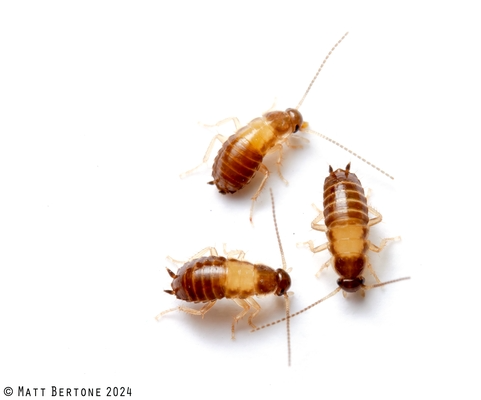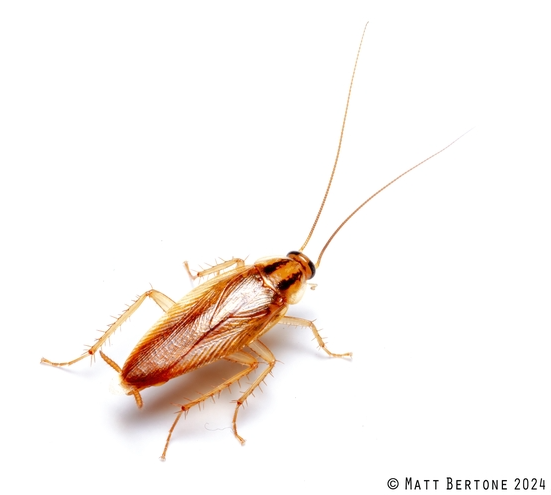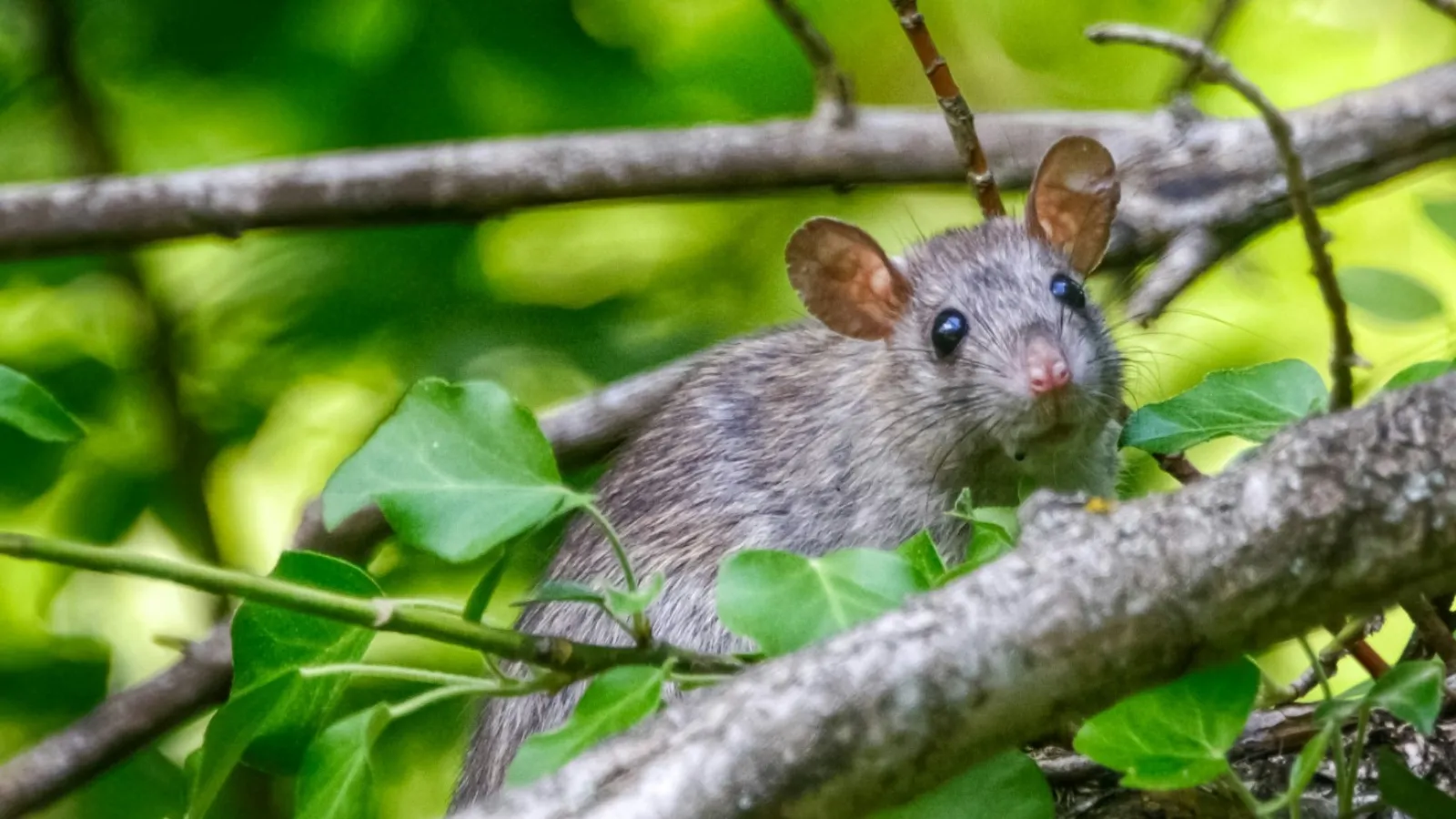
Frequently Asked Questions
Find answers to the questions we get most often
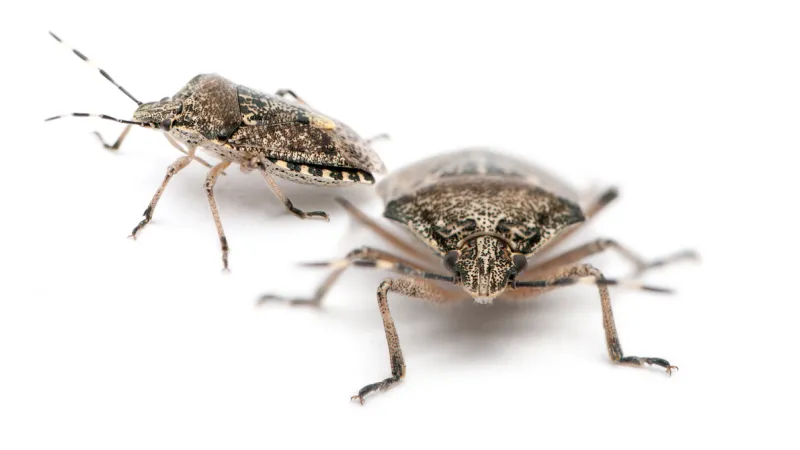
Pest Control
Frequently Asked Questions
What is Integrated Pest Management?
Integrated Pest Management (IPM) is an environmentally-conscious approach to pest control that relies on a combination of education and training. An IPM program utilizes biological information based on the type of pest that has been identified. Information gathered, in combination with advanced pest control procedures, is used to manage the pest with the most thorough and environmentally sensitive method of control.
Why do I still see pests in my home?
While our pest control specialists diligently work to keep your home and business pest-free, insects can sometimes still find their way in. After all, we are battling a force of Mother Nature. Since there is always the possibility of insects entering your home or business, our Quarterly Pest Control program is guaranteed. If you continue to see an issue, contact us to schedule an extra service call at no additional charge.
How are pests getting inside my home?
Insects adapt to survive. Therefore, insects will find any gap, crack or crevice to enter your home or business. While a pest-proof home would be nice, attaining such a goal is highly unlikely. Our pest control service includes an inspection of your home or business by a pest control specialist and a list of conditions that might allow insects to enter and thrive.
Are the pest control products you use safe for me, my children and my pets?
All of the products we use are safe for you, your family and your pets. Our highly trained pest control specialists evaluate and process each situation, then factor in Integrated Pest Management to minimize the risk of exposure while maximizing the effectiveness of each product.
I don’t see any pests in my home. Can I skip a quarterly service call?
While we are happy that we have eradicated insects from your home or business, it is imperative that we continue to maintain a pest barrier around the exterior. Skipping a quarterly service call can allow an infestation to grow and become a problem that may take our pest control specialists several trips and time out of your schedule to control.
I just had my quarterly service call, then it rained. Do you need to come back?
Each situation is a little different, so there is no definitive answer to this question. Our pest control specialists perform four key treatments each service. Two of these treatments - crack and crevice and insecticide granules - are not as susceptible to weather. However, if you experience any pests, Palmetto Exterminators' Quarterly Pest Control program is guaranteed, and therefore an extra service may be performed at no extra cost.
Do you have to come inside for a quarterly service call?
Our quarterly residential pest control program greatly reduces interior applications, especially when there are no specific interior pest problems. Should you, however, have an interior problem, there is no additional charge for treating the interior.
I have pests in my house but I’m not sure what they are. How can I find out?
Please browse our Pest Library for help identifying the insect. Should you not find the pest you are looking for, please contact us. Our skilled pest control experts will assist you.

Termite Control
Frequently Asked Questions
What can I do to prevent termites?
Preventing termites is best accomplished through regular inspections of your home or business and treatment, but there are some things you can do to reduce your chances of a pest control problem:
- Divert water away from your home or business with properly functioning downspouts, gutters and splash blocks.
- Quickly repair any structural damage caused by moisture, such as a roof leak or plumbing leak.
- Perform routine maintenance, such as caulking, painting windows and cleaning your gutters.
- Reduce humidity in crawl spaces.
- Prevent shrubs, vines and other vegetation from growing over and covering vents and growing on the exterior of your home or business.
- Eliminate wood contact with the ground around your home or business.
- Remove any wood or construction debris from your crawl space and around your home or business.
Can I treat termites on my own?
Do-it-yourself termite control is certainly an option. However, most owners lack the knowledge and training that professionals have to treat termite problems effectively.
An essential component of treating a termite problem effectively is correctly identifying the termite species and developing a course of treatment that takes the species's biology and habits into account. It is also critical that products are handled properly to ensure effective treatment. A pest control specialist from Palmetto Exterminators has the training and expertise to provide the most effective solution to your termite problem.
I just bought a house that you have under warranty. Do I have to pay a fee to transfer it to my name?
Our termite service agreements transfer at no cost. If you just purchased a home under warranty with Palmetto Exterminators, all you have to do is provide us with your name and contact information. Our pest control experts will take care of the rest.
Why should I renew my termite service agreement?
According to the NPMA, every year termites cause more than $5 billion in damage with the average repair costing $2,500 to $5,000. That does not include the cost of treating and removing the termites.
With a termite service agreement with Palmetto Exterminators, you would not be responsible for any of the repair or re-treatment costs.
How can I tell the difference between flying ants and termites?
Termites are often confused with ants. However, a few simple things distinguish the two.
Termites have straight antennae, a broad waist and short legs. Both wings are the same size and shape with a lace-like appearance.
Ants have elbowed antennae; a thin, pinched waist; and long legs. Their hind wings are smaller than the front wings.
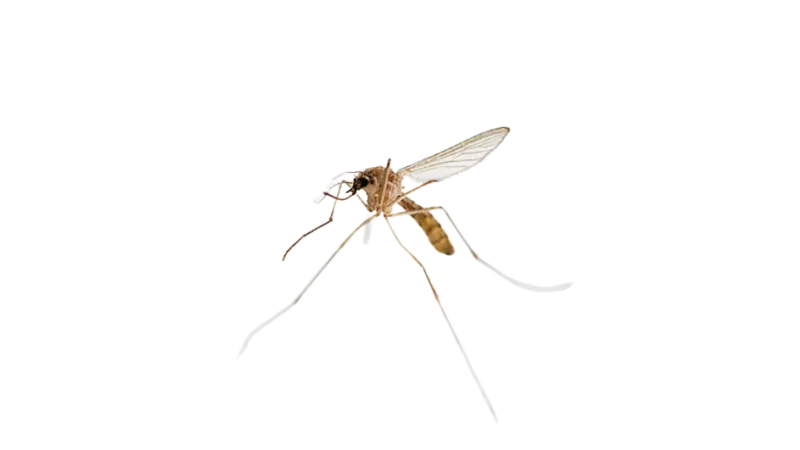
Mosquito Control
Frequently Asked Questions
What are some things I can do to reduce mosquitoes around my home?
In addition to a mosquito control service, there are several measures you can take to get rid of mosquitoes around your home.
- Replace any standing water in bird baths, ponds, or pools at least once weekly to reduce breeding sites.
- Introduce mosquito-eating fish to ponds with standing water.
- Turn over any empty flower pots, children's toys, and other objects that might hold water.
What health risks do mosquitoes pose?
Mosquitoes are known vectors of several serious parasites and illnesses. Some of the most serious are West Nile Virus, Malaria, Chikungunya, and Yellow Fever. More information can be found here or on the Centers for Disease Control's website.
How long will a barrier treatment last?
Our mosquito treatments are designed to last between 3 to 4 weeks. Depending on weather and other environmental factors, mosquito treatment may not last as long. Our monthly mosquito barrier treatments are a guaranteed service. If you do not see results, call us, and we will come back out for an extra mosquito treatment service at no additional cost.
My town/city/county sprays for mosquitoes. Why do I need your service?
Municipal mosquito treatment services are designed to reduce the population of mosquitoes on a large scale and not necessarily for the comfort of individuals. Our mosquito treatment services are customized to your home and your needs. We aim to allow your family to get out and enjoy your yard without worrying about being bitten by mosquitoes.
Are mosquito traps or magnets a good alternative to a misting system and treatment program?
You cannot compare the mosquito magnet to a misting system or Palmetto Mosquito Control's Barrier Service. Mosquito traps or magnets capture only the insects located downwind of the machine. There is no independent field research that supports the manufacturers' claims that mosquito traps reduce the population of mosquitoes and gnats in a specific outdoor area. One female mosquito can produce about 1,500 eggs that will emerge as adults in about 15 days. Many of our customers owned one or more mosquito magnets before purchasing our system or service.
When should I consult a professional about my mosquito problem?
Mosquitoes carry a variety of diseases, and it's important not to expose yourself, members of your family, or pets to illness. If you get mosquito bites while outside, Palmetto Mosquito Control is happy to provide a free estimate for any of our mosquito treatment services. We can devise a proper treatment plan with either a Mosquito Misting System, a Mosquito Barrier Treatment, a one-time Special Event Treatment, or a Neighborhood Mosquito Control program. Get your free inspection today.
When is mosquito season?
Mosquitoes hibernate during winter and return when the temperature rises during the spring, which can be early as February or March in North and South Carolina. Mosquito populations peak during the summer when it's the hottest, so bug spray or treatments are extremely important during June, July, and August.
Are mosquito treatments and sprays harmful to pets?
To minimize potential exposure to pests we suggest that animals remain indoors for at least thirty minutes after treatment is applied.
Do I need a mosquito misting system?
Palmetto Mosquito Control can minimize the risk of exposure by installing a misting system. Precise placement of nozzle heads allows the product to be distributed to the most beneficial area and minimizes potential accident exposure to children, pets, and adults. During installation, we make sure that both the tank and operating system are hidden from view and securely locked.
How do mosquitoes spread disease?
Mosquitoes are considered a vector for disease; in other words, they can transfer disease from one human to the next. If a mosquito feeds on an infected host, it spreads this virus or disease to the next person they feed on. This causes diseases such as Zika or West Nile Virus to spread rapidly.
How long does a mosquito live?
Mosquitoes can live anywhere from 4 days to an entire month. Their lifespan primarily depends on weather and living conditions. On average, females have a much longer lifespan than males at 42-46 days compared to males living only about 2 weeks.
What attracts mosquitoes to humans?
Initially, mosquitoes locate humans by the carbon dioxide we all exhale. Once the mosquito gets closer, they notice bodily functions and scents such as moisture, sweat, scent, and even the heat from your body temperature.
Why are some people more prone to mosquito bites than others?
This question remains somewhat of a mystery. However, the reason why some humans get bitten more than others might come down to blood type, body scent, or perfume.
A recent study found that people with blood Type O were more likely to get bit because mosquitoes are attracted to this type of blood for unknown reasons. In this study, those with blood Type A were the least likely to get bit, and blood Type B was found somewhere in the middle. Besides blood type, mosquitoes are also attracted to certain chemicals in your skin that some people produce more than others, such as lactic acid.
Why do mosquito bites itch?
All mosquito bites are from female mosquitoes since they need the nutrients in the blood to produce eggs. When a female mosquito bites an animal or human, she pierces the skin and begins to feed. As she does this, she injects her saliva that contains an anticoagulant to prevent your blood from clotting around the bite, allowing her to feed much faster.
Your body recognizes the protein in the mosquito's saliva as an attack or foreign substance and immediately releases histamine to the bite, causing the redness and swelling of an allergic reaction. In other words, the swelling and itching you feel after the bite is a reaction from the histamine your body produces due to the mosquito's saliva.
When do mosquitoes usually feed?
The native southern house mosquito mostly feeds at dusk and dawn because they don't usually like direct sunlight. However, with the introduction of the Asian Tiger Mosquito, an invasive species, bites can happen almost any time of day.
Are mosquitoes attracted to water?
Mosquitoes can live in water, and females lay their larvae in pools of water. Once the larvae hatch, they spend their first two stages of life primarily in water. This is also what attracts mosquitoes to humidity, as well as humans, due to the water vapor that we all exhale.

Moisture Control
Frequently Asked Questions
How long does crawl space encapsulation last?
Palmetto Exterminators uses high-quality materials to professionally encapsulate your crawl space, ensuring durability and long-term protection. When existing moisture issues are properly addressed and routine maintenance—such as dehumidifier servicing and periodic inspections—is performed, your encapsulation system can last 15 years or more. It's also important to promptly repair any leaks or damage to the vapor barrier to maintain its effectiveness over time.
Will encapsulation help with pests?
Yes. By eliminating the moisture and access points that attract pests, encapsulation reduces the likelihood of infestations from termites, rodents, cockroaches, and other crawl space invaders.
What is a vapor barrier, and why do I need one in my crawl space?
A vapor barrier is a thick plastic sheet installed on the floor of your crawl space to block moisture from rising up through the soil. Without a vapor barrier, humidity can accumulate and lead to mold growth, wood rot, poor air quality, and pest infestations. When done professionally, it's a simple but highly effective way to manage moisture and protect your home.
How is a vapor barrier different from full encapsulation?
A vapor barrier is a highly effective moisture control solution that covers the crawl space floor, blocking ground moisture from rising into your home. While full encapsulation adds additional protection by sealing walls, vents, and often includes a dehumidifier, a properly installed vapor barrier alone can significantly reduce humidity levels, prevent mold growth, and protect your home's structural integrity. It's an excellent option for homeowners looking for strong moisture defense without the need for full encapsulation.
Can a vapor barrier prevent mold and mildew?
Yes, a properly installed vapor barrier helps prevent mold and mildew by reducing the ground moisture that feeds their growth. While not a cure-all, it's a crucial first step in keeping crawl spaces dry and mold-free.
Do I still need a dehumidifier if I have a vapor barrier?
In some cases, yes.
A vapor barrier helps control ground moisture, but if humidity is entering from other sources (like wall vents or leaks), a dehumidifier may still be necessary to keep humidity levels under control. Our Palmetto Exterminator crawl space professionals will evaluate and discuss options with the homeowner.
How long does a vapor barrier last?
With Palmetto Exterminator's professional installation and minimal disruption, a vapor barrier can last 10 to 20 years. Thicker materials and regular inspections help ensure it stays intact and continues to protect your crawl space.
What happens if I don’t seal my crawl space right?
Without proper moisture control, your crawl space is vulnerable to high humidity, wood rot, mold growth, pest infestations, and even structural issues over time. Moisture can also seep into your home, reducing indoor air quality and driving up energy bills.
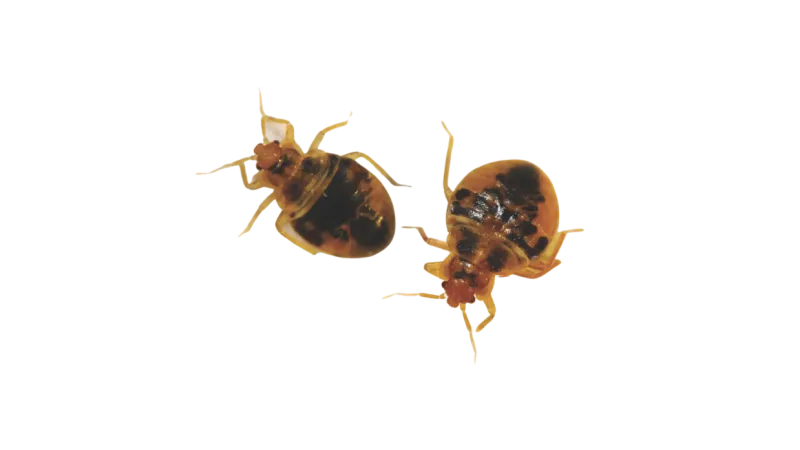
Bed Bugs
Frequently Asked Questions
How do bed bugs get into my home?
Bed bugs are expert hitchhikers, often traveling undetected in luggage, furniture, or clothing. They're especially common in hotels and apartment buildings with existing infestations.
Can I get rid of bed bugs myself?
Yes and no. It's possible to kill a few visible bed bugs with over-the-counter sprays or home remedies, but truly eliminating an infestation is extremely difficult without professional help from Palmetto Exterminators. Bed bugs are experts at hiding, reproducing quickly, and often develop resistance to common pesticides found in DIY products.
Many homeowners unknowingly make the problem worse by:
-
Only treating surfaces, not the cracks and crevices where bed bugs hide and lay eggs
-
Failing to kill bed bug eggs, which hatch later and re-start the infestation
-
Spreading the bugs to other areas of the home while trying to clean or move furniture
Bed bug infestations often require targeted insecticides, dusts, or heat treatments—methods that need professional tools, experience, and safety protocols. At Palmetto Exterminators, our trained technicians conduct a thorough inspection and create a tailored plan using EPA-approved products that reach deep into the places bed bugs hide, ensuring the infestation is controlled at every stage of the life cycle.
If you want fast, effective, and lasting results, the safest option is to skip the guesswork and let a pest control professional take care of the problem.
Are your bed bug treatments safe for pets and children?
Yes. We use EPA-approved products and methods that are safe for your entire household when used as directed.
How long does a bed bug treatment take?
Most treatments are completed in a few hours, though follow-up visits may be required depending on the severity of the infestation.
Do I need to leave my house during a bed bug treatment?
Yes. All people and pets should leave the home and remain out for at least 4 hours after treatment. Your technician will give you exact instructions.
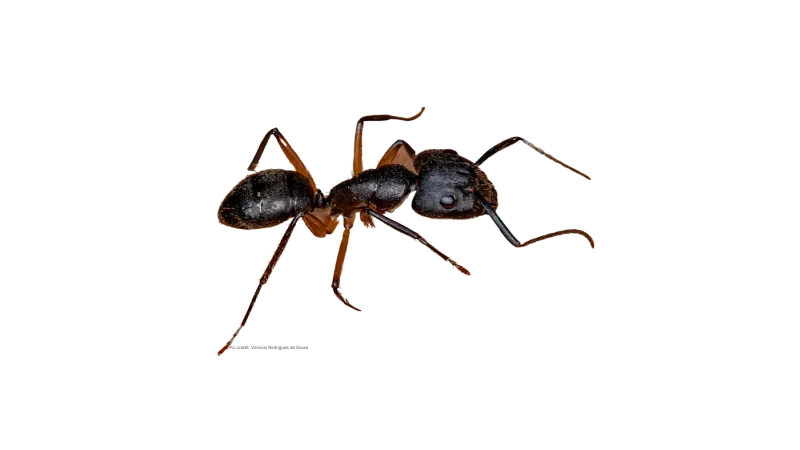
Carpenter Ant
Frequently Asked Questions
Why Carpenter Ants Are a Threat
While they don't consume wood like termites, carpenter ants tunnel and nest inside it—especially in damp or decaying wood. Left untreated, they can:
-
Compromise beams, joists, and structural elements
-
Nest in attics, wall voids, windowsills, and crawl spaces
-
Expand colonies across floors and outbuildings
-
Return season after season if not fully eliminated
The longer you wait, the more extensive and expensive the damage can become.
What do carpenter ants look like?
Carpenter ants are typically black or red and range from ¼ to ½ inch long. Unlike termites, they have elbowed antennae and a pinched waist.
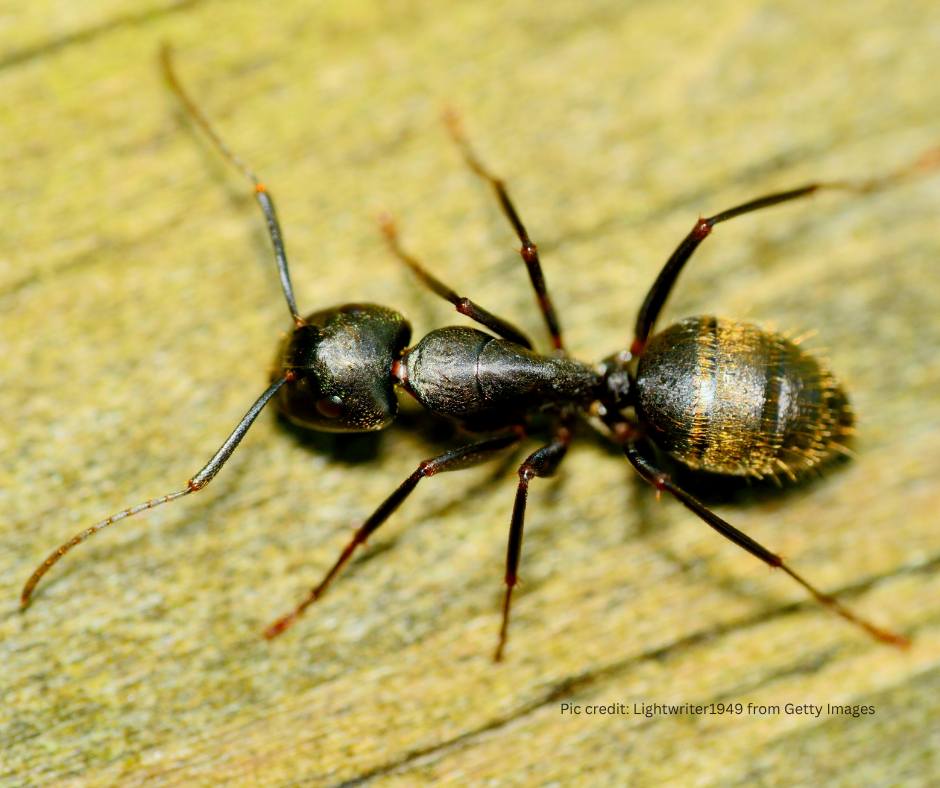
How can I tell the difference between termites and carpenter ants?
Carpenter ants have segmented bodies with narrow waists, bent antennae, and front wings longer than back wings. Termites have thick waists, straight antennae, and equal-length wings.
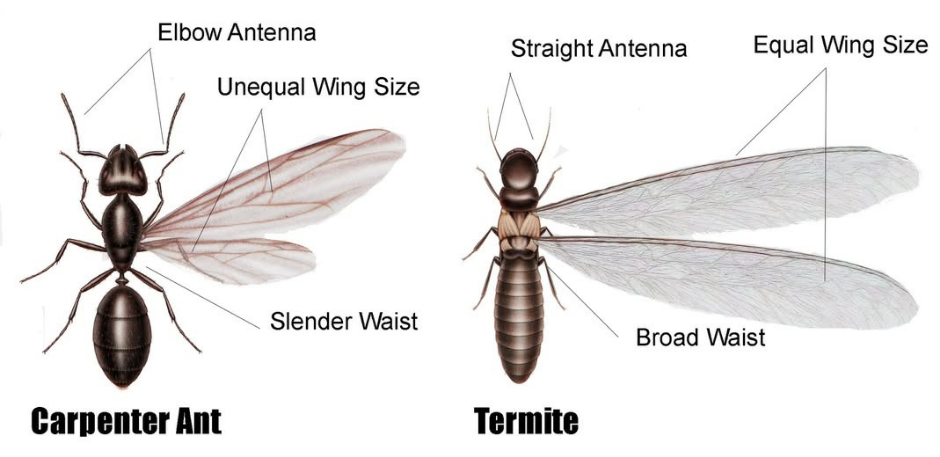
Are carpenter ants dangerous to my home?
Yes. Although they don't eat wood, they excavate or dig into it to build nests. Over time, this can weaken structural supports and lead to expensive repairs.
What attracts carpenter ants to a home?
Carpenter ants are attracted to moisture-damaged wood, poor drainage, leaky gutters, and decaying vegetation. Regular maintenance and inspections help reduce risk.
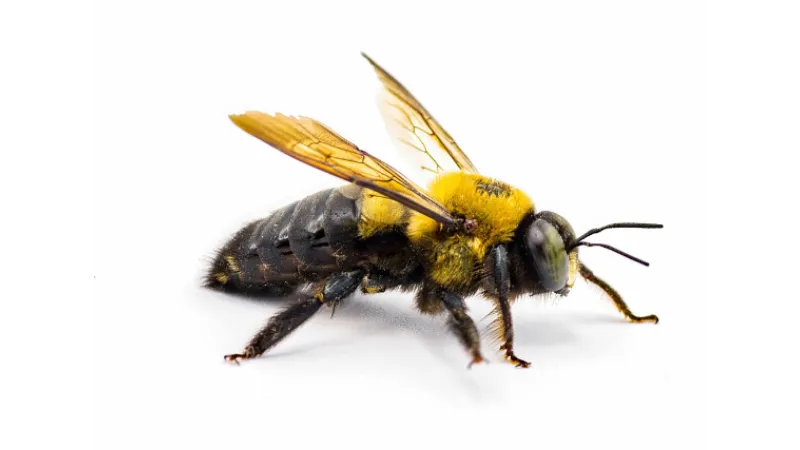
Carpenter Bee
Frequently Asked Questions
What Are Carpenter Bees?
Carpenter bees are large, solitary bees that resemble bumblebees but have shiny, hairless abdomens. Unlike bumblebees, which live in colonies, carpenter bees are solitary and get their name from their nesting habits—they tunnel into wood to create nests for their offspring.
These bees are typically black and yellow, and you'll often spot them hovering near wooden decks, eaves, railings, or fences in spring and early summer. While male carpenter bees may seem aggressive and will hover in your face, they don't have stingers. Females can sting but usually only do so when provoked.
Though carpenter bees play a valuable role in pollination, their nesting behavior can cause significant damage to wooden structures over time, especially if multiple generations reuse the same area. Left untreated, carpenter bee activity can weaken wood, lead to unsightly holes, and attract woodpeckers searching for larvae.
Signs of a Carpenter Bee Infestation
Signs of a Carpenter Bees include:
-
Perfectly round holes in wood (typically ½ inch wide)
-
Piles of sawdust or "frass" below the hole
-
Yellow-brown staining near the entry site (from bee waste)
-
Buzzing or hovering bees near eaves, railings, or wooden decks
-
Repeated holes in the same area from returning bees each season
Carpenter bees prefer softwoods like pine, cedar, or redwood and often target homes, barns, porches, fascia boards, sheds, and play structures.
Are Carpenter Bees Dangerous?
While one or two bees may seem harmless, over time they can cause extensive wood damage. Carpenter bees reuse and expand old tunnels year after year, which can lead to:
-
Weakened structural components
-
Increased moisture entry and rot
-
Attraction of woodpeckers (who dig for larvae, causing more damage)
Also, multiple females may nest in the same area, creating a large colony, which only exacerbates the problem.
Do carpenter bees sting?
Male carpenter bees cannot sting. Females can sting, but they are not aggressive and usually only do so if directly handled.
Do carpenter bees come back every year?
Yes. Carpenter bees often reuse old nests and can expand tunnels year after year. Sealing holes and treating wood can help prevent return activity.
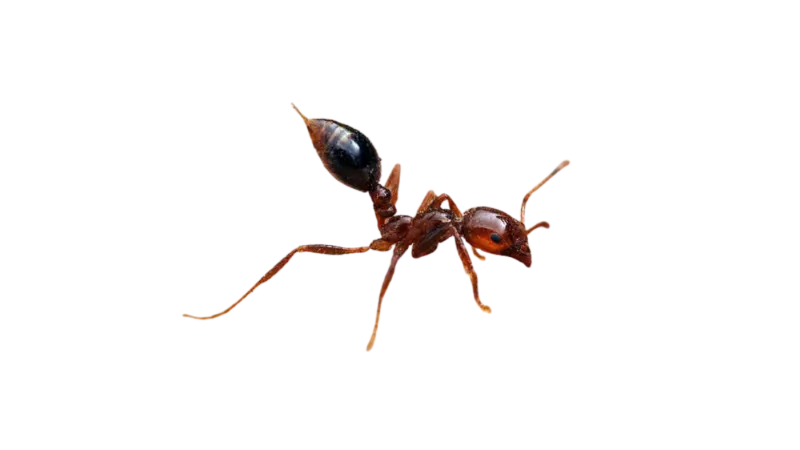
Fire Ant
Frequently Asked Questions
Signs of a Fire Ant Infestation
Common signs of fire ants include:
-
Raised, dome-shaped mounds (up to 18 inches wide) in sunny areas
-
Sudden swarms of ants when a mound is disturbed
-
Painful stings or visible red bumps on pets or people
-
Ant activity around electrical equipment or air conditioners
-
Trails of reddish ants near foundations or outdoor structures
Unlike other ants, fire ants do not have a central nest—you may have dozens of colonies spread across your property.
Are Fire Ants Dangerous?
Yes. Fire ants are a serious concern for:
-
Children and pets, who may unknowingly disturb mounds while playing
-
Landscapes, as their nests damage turf and soil structure
-
Electrical equipment, which they often invade and short-circuit
-
People with allergies, who may have strong or life-threatening reactions to stings
If left untreated, fire ants multiply quickly and expand their territory—making control harder over time.
Are Carpenter Bees Dangerous?
While one or two bees may seem harmless, over time they can cause extensive wood damage. Carpenter bees reuse and expand old tunnels year after year, which can lead to:
-
Weakened structural components
-
Increased moisture entry and rot
-
Attraction of woodpeckers (who dig for larvae, causing more damage)
Also, multiple females may nest in the same area, creating a large colony, which only exacerbates the problem.
Do carpenter bees sting?
Male carpenter bees cannot sting. Females can sting, but they are not aggressive and usually only do so if directly handled.
Do carpenter bees come back every year?
Yes. Carpenter bees often reuse old nests and can expand tunnels year after year. Sealing holes and treating wood can help prevent return activity.
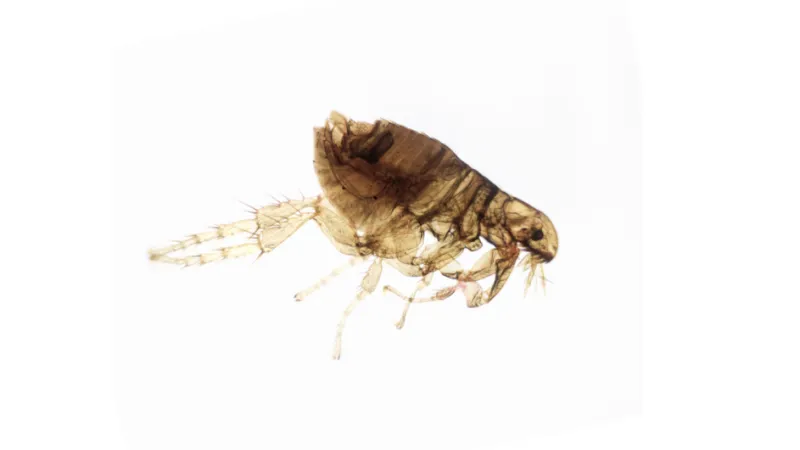
Flea
Frequently Asked Questions
Signs of a Fleas
You may have fleas if you notice:
-
Pets scratching excessively or biting their skin
-
Small, red bites around ankles, legs, or waistlines
-
Live fleas that are visible in pet fur or bedding
-
Flea dirt (black specks) on your pet's skin or your floors
-
Sudden jumping insects seen on socks or when walking indoors
Are Fleas Harmful?
Yes. Fleas can cause health issues for both people and pets, including:
-
Allergic dermatitis (itchy skin reactions)
-
Tapeworm transmission
-
Anemia in severe infestations
-
Secondary infections from scratching
-
Bartonella (cat scratch disease) transmission
How do fleas get into my house?
Fleas often hitch a ride on pets, people, or clothing. They can also enter through open doors or windows and infest your yard, eventually migrating inside.
Can fleas live in carpet and furniture?
Yes. Flea eggs, larvae, and pupae can hide in carpeting, rugs, bedding, and upholstered furniture.
Are flea bites harmful?
Yes, flea bites can be harmful, especially if left untreated or if the infestation is severe. While a single bite may just cause minor irritation for some people or pets, others may experience more serious reactions.
Here are a few ways flea bites can be harmful:
-
Itching and Skin Irritation: Flea bites typically cause red, itchy bumps that can lead to excessive scratching. This can break the skin and lead to secondary bacterial infections.
-
Allergic Reactions: Some people and animals are allergic to flea saliva, which can result in flea allergy dermatitis (FAD). This causes intense itching, rash-like symptoms, hair loss in pets, and skin inflammation.
-
Infections: Scratching flea bites increases the risk of developing skin infections such as impetigo or cellulitis, especially in children or pets with sensitive skin.
-
Disease Transmission: Fleas can transmit tapeworms to pets (and occasionally to humans), and in rare cases, fleas may spread serious illnesses like murine typhus or even the plague.
-
Anemia in Pets: Severe flea infestations in pets—especially in young kittens or puppies—can lead to anemia due to blood loss, which can be life-threatening if left untreated.
Will one treatment get rid of fleas?
One flea treatment may be enough for minor infestations, but because of the flea's life cycle, we often recommend a follow-up in 10-14 days to eliminate newly hatched fleas.
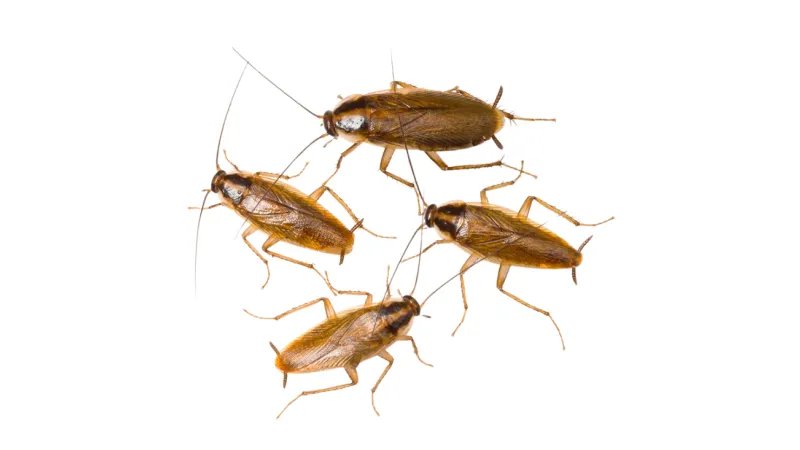
German Cockroach
Frequently Asked Questions
What do German cockroaches look like?
Where do German cockroaches hide?
German cockroaches prefer warm, humid, and dark places close to food and water. Common hiding spots include behind refrigerators, under sinks, inside cabinets, in cracks and crevices, and near dishwashers or stoves.
Are German cockroaches dangerous?
Yes. They can carry bacteria like salmonella and E. coli, contaminate food, and trigger asthma and allergies—especially in children and sensitive individuals.
How do German cockroaches get into homes?
They typically enter homes via grocery bags, cardboard boxes, used appliances, or furniture. Once inside, they reproduce rapidly and spread throughout kitchens, bathrooms, and utility rooms.
Why are German cockroaches so hard to get rid of?
German cockroaches are among the most challenging household pests to eliminate—and for good reason. They're highly adaptive, reproduce rapidly, and have built up a strong resistance to many common treatments. Without professional intervention, what starts as a minor issue can quickly become a widespread infestation.
These pests multiply faster than nearly any other household insect. A single female can produce an egg case (called an ootheca) every few weeks, each containing 30 to 40 eggs. Over her lifetime, she may generate hundreds of offspring. With access to food and moisture, a small presence of German cockroaches can explode into a full-blown infestation in just a few months.
Making matters worse, German cockroaches have developed resistance to many over-the-counter insecticides. While store-bought sprays might kill a few visible bugs, they often leave the reproductive adults and hidden populations untouched. In some cases, improper treatments can even drive roaches deeper into walls and cabinets, spreading the infestation to new areas. And even if adult roaches are eliminated, their egg cases—highly protected and often well hidden—can continue to hatch, allowing the problem to resurface again and again. That's why targeting all life stages with the right strategy is critical for lasting control.
What is the best way to prevent a German cockroach infestation?
Prevention includes sealing entry points, keeping kitchens clean and dry, storing food in airtight containers, fixing leaks, and taking out trash regularly. Avoid bringing home used appliances or boxes without inspection.
